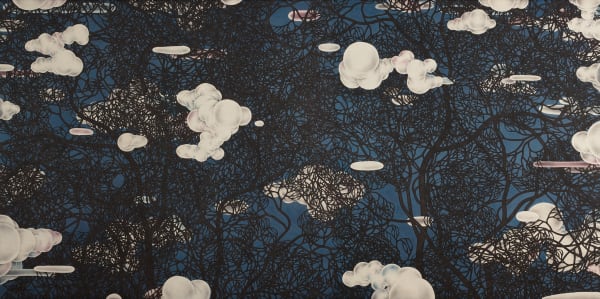-
Curator: Craig L. Yee
Dates: September 20, 2024 – December 1, 2024
INKstudio is proud to present "Iconology of Life," the first solo exhibition for the Guangdong-born visual artist Lao Tongli (b. 1982). Lao Tongli is a contemporary artist working in the early gongbi or "meticulous brush" mode of painting-a tradition which can trace its roots to Imperial painting of the Song Dynasty (960-1279) and religious mural painting dating as far back as the the Six Dynasties period (220-589). Unlike China's literati painting tradition which emphasized landscape painting in ink monochrome, gongbi painting often depicted moral, spiritual and religious narratives using vibrant mineral pigments such as azurite, malachite, lapis lazuli, lead, cobalt and cinnabar. Having entered China as early as the 3rd Century along the Silk Road from Central Asia, gongbi painting facilitated cross-cultural artistic exchange between China, Central Asia, the Middle East, East Asia and Europe over the ensuing millenia. As a result, gongbi painting shares many of the same materials and techniques found in European fresco painting, Persian or South Asian miniature painting, Tibetan thanka painting, and Japanese Nihonga painting.
-

-
Xin: Heart
-
In his The Desire of Libido series, Lao Tongli deptics a vast network of branching and inter-connected blood vessels in a dazzling array of chromatic hues. As doctors cared for his father who was ailing from heart disease, Lao Tongli poured over radiological images of his father's heart and started painting these works as a meditation on his father's illness and a means of mourning his subsequent passing. Blood is the carrier of our qi or "life energy" and blood vessels the branching pathways that transport this life energy to every corner of our mind-body. In Chinese philosophy, the xin or "heart-mind" is the seat of all subjective experience including our embodied thoughts, senses, feelings, emotions, imagination, and memories. The Desire of Libido is thus the universal impulse that drives not only the creation and proliferation of organic life but the emergence of each individual organism's consciousness and will to live.
-
Lin: Trees
-
Over time, Lao Tongli's networks of blood vessels began to take the form of trees. Lao Tongli's tree forms stem from his memories of the enormous Banyan or Ficus microcarpa trees that grew up and around the rural village of his childhood. Banyan tree holds religious and spiritual significance across Asian cultures. In Buddhism, Ficus religiosa is also known as the "Bodhi Tree" because Sakyamuni Buddha attained enlightenment beneath one such tree in 6th Century B.C.. Ficus benghalensis is the species of Banyan tree under which Krishna delivered his sermon in the Bhagavad Gita. In Southern China, Ficus macrocarpa, or Chinese Banyan, are worshipped by rural villagers as local spirits or gods that brings good fortune, longevity and enlightenment. As each branch forks into smaller branches and smaller branches fork into twigs, the trees-each distinctly rendered in its own vibrant hue-weave themselves into a dense network. Lao Tongli's branches terminate in a point but each of these tips then touches the tips of its neighboring tree. In this way, all of Lao Tongli's trees are connected into something larger-a super-organism, a community, a society or an entire eco-system. This ecological or organismic view of reality is what the great twentieth-century sinologist Joseph Needham described as the "organic naturalism" or "organicism" of the traditional Chinese world-view.
-
Tian: Sky or Nature
-
In the series Above the Horizon · Sky (2018-present), Lao Tongli recalls growing up as a child in the open expanse of the rural countryside. For him, the image of the sky evokes a sense of the vast openness of nature and looking up at the sky, a sense of hope and possibility. In some works, he depicts the sky as seen from below through the tangled branches of the pippala trees of his village. In others, he shifts perspective to one above the trees and amongst the clouds. In classical Chinese philosophy, tian or "the sky" represents the natural order of the cosmos and encompasses not only the movement of the sun, the moon and the stars but the cycles of the day and the seasons, changes in the weather and climate and the flow of water and qi through the landscape. The sky, thus, embodies the inorganic source of life's energy and its pulsing, dynamic flow through the living systems of the natural world.
-
Ren: Self and Others
-
In the most recent series Self and the Others (2021-present), Lao Tongli extends his lexicon of images to include the human body-our "self"-in relation to a larger ecosystem of "other" living organisms of which we are just a part. Compared to The Desire of Libido series which imagines the embodied experiences of the subjective "heart-mind", Lao Tongli's image of the human form in Self and the Others refers to humanity and its relationship to the world in the abstract. Using the same branching structures to describe both the human body and the larger world or ecosystem of which humanity is an inseparable part invokes the deep and unbreakable bond between humans and the natural world-the holistic Chinese idea of tian ren he yi, that "humanity and nature are one." Qi"vital energy" flowing from tian or the "sky" or "cosmos" circulates through lin "forests" or "ecosystems" that encompass both ren "humanity" as a whole and xin our subjective "conscious experience" as individuals.
-




















